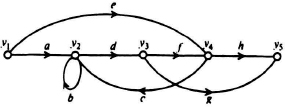2.14. SIGNAL-FLOW GRAPHS AND MASON’S THEOREM
Signal-flow graphs and Mason’s theorem [7, 8] enable the control engineer to determine the response of a complicated linear, multiloop system to any input much more rapidly than do block-diagram reduction techniques.
A signal-flow graph is a topological representation of a set of linear equations having the form
The equation expresses each of the n variables in terms of the others and themselves. A signal-flow graph represents a set of equations of this type by means of branches and nodes. A node is assigned to each variable of interest in the system. For example, node i represents variable yi. Branch gains are used to relate the different variables. For example, branch gain aij relates variable yi to yj, where the branch originates at node i and terminates at node j. Consider the following set of linear equations
The signal-flow graph which represents this set of equations is shown in Figure 2.12. Here y1 can be interpreted as the input to the system and y5 as its output. Usually we would be interested in obtaining the ratio of y5/y1 although we might also be interested in determining the ratio of y2/y1.
Before proceeding further, several terms used in signal-flow diagrams must be defined.
(a) A source is a node having only outgoing branches, such as y1 in the preceding illustration.
Figure 2.12 Signal-flow graph.
(b) A sink is a node having only incoming branches, such as y5.
(c) A path is a group of connected branches having the same sense of direction. In Figure 2.12, eh, adfh, and b are paths.
(d) Forward paths are paths which originate from a source and terminate at a sink and along which no node is encountered more than once, as eh, ecdg, adg, and adfh.
(e) Path gain is the product of the coefficients associated with the branches along the path.
(f) Feedback loop is a path originating from a node and terminating at the same node. In addition, a node cannot be encountered more than once. In the preceding example b and dfc are feedback loops.
(g) Loop gain is the product of the coefficients associated with the branches forming a feedback loop.

